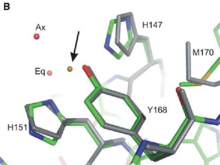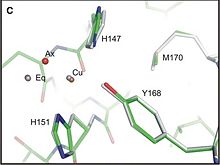Sandbox Reserved 713
From Proteopedia
Alzheimer's amyloid precursor protein copper-binding domain
| |||||||||
| 2fkl, resolution 2.50Å () | |||||||||
|---|---|---|---|---|---|---|---|---|---|
| Gene: | APP (Homo sapiens) | ||||||||
| Related: | 1owt, 2fjz, 2fk1, 2fk2, 2fk3 | ||||||||
| |||||||||
| |||||||||
| Resources: | FirstGlance, OCA, RCSB, PDBsum | ||||||||
| Coordinates: | save as pdb, mmCIF, xml | ||||||||
Introduction
2FKL is located in a transmembrane protein called APP for Amyloid precursor protein. This domain going from residue 124 to 189 is localized in the extracellular part of APP just between the Growth Factor Domain (GFD) and the Acidic domain, in a region called Cu-Binding Domain which is able to bind Cu and Zinc.
This proteins plays a major role into the development of Alzheimer disease[1]. APP cleavage by BACE and gamma secretase gives ended rise to the Aβ peptide, which forms at the end an aggregation of amyloid plaques [2] .
As the interaction between copper ion and APP can modulate the production of Aβ peptide [3] and also the progression of Alzheimer disease, structural studies of the Cu-binding Domain of this protein give a lot of information for the development of novel therapeutics.
Structure
| |||||||||||
Medical Implication
An Alzheimer disease is responsible for the most comon form of dementia among old people.)Causes of this disease are not clear but genes and environmental factors seem to play a major role. (lien au dessus) It is characterized by extensive neuronal death, shrinkage of the brain and also the presence of amyloid plaques into the brain.( article principale) These plaques are concentrated with Aβ peptide which results from the anormal cleavage of APP by successive action of the β and γ secretases. The alteration in copper homostasis is directly related to the progression of Alzheimer disease. The impact of Cu(II) on the aggregation of Aβ peptide is still discussed even if Cu(II) is find in elevated concentration in these plaques. [6]
If the CuBD (located in E1 region) does contribute to APP dimerisation without Cu ions, that mean that the Cu binding may reduce AB production, either by shifting the monomer-dimer equilibrium to favor monomer form, or by re-orienting the dimer form, which disfavour the aB production. [7]



